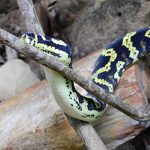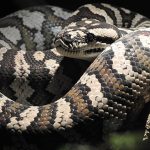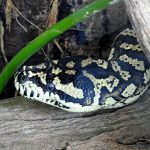The Jungle Carpet Python
The Jungle Carpet Python is one of the most striking snakes in Australia, admired for its bold patterns and impressive adaptability. This non-venomous python is native to the lush rainforests and coastal regions of north-eastern Australia, particularly in Queensland and the northern parts of New South Wales. Its distribution stretches from the Cape York Peninsula down through the tropical and subtropical forests, following waterways, woodlands, and even extending into areas where humans live.
Habitat and Environment
These snakes are true masters of survival, thriving in a wide range of environments:
- Rainforests with thick canopy cover and humid air
- Wet sclerophyll forests where tall eucalypts tower overhead
- Woodlands and more open habitats with scattered trees and shrubs
- Suburban gardens where they sometimes take refuge in sheds, roof spaces, or near compost heaps rich with rodent prey
They are often found in close proximity to water sources, such as streams, rivers, and ponds, which attract the small animals they feed upon.
When you picture one resting in a rainforest, imagine the smell of damp leaf litter beneath towering trees, the sound of cicadas buzzing in the heat, and the sense of stillness interrupted only by the rustle of a python winding its way through branches.
Appearance and Adaptations
The Jungle Carpet Python is perhaps the most visually stunning of the carpet python subspecies. Their bodies display bold black-and-gold patterns, sometimes with olive or brown tones. These intricate markings are not just beautiful — they serve as camouflage, breaking up the snake’s outline against the dappled light of the forest floor or the rough bark of a tree trunk.
Their size varies, but adults can grow between 2 to 4 metres in length, with some exceptionally large individuals exceeding this. Despite their size, they move gracefully, aided by a prehensile tail that helps them climb and balance in trees.
Diet and Hunting Behaviour
Carpet pythons are ambush predators. They rely on patience and camouflage, lying in wait until an unsuspecting creature passes by. Their diet is diverse and includes:
- Mammals such as possums, rodents, and bats
- Birds, sometimes taken directly from nests
- Reptiles, including lizards
When prey comes close, the python strikes with speed, coils its muscular body around the animal, and constricts until the prey can no longer breathe. They then swallow it whole, aided by flexible jaws capable of opening wide.
Primarily nocturnal, these snakes are most active at night, when the forest hums with life and small animals emerge to feed.
Life Cycle and Reproduction
Like all pythons, the Jungle Carpet Python is oviparous — it lays eggs rather than giving birth to live young. After mating, the female deposits a clutch of 10 to 30 eggs in a sheltered location. What makes pythons unique among snakes is the maternal care they provide: the female coils around her eggs, using tiny muscular shivers to generate heat and keep them warm until hatching.
The incubation period lasts 50 to 70 days, after which the hatchlings emerge, each no longer than 40–60 cm. From the very first day, these young pythons are independent and must fend for themselves.
Conservation and Human Connection
Although the Jungle Carpet Python is not currently listed as threatened, it faces pressures from:
- Habitat loss and fragmentation, as forests are cleared for agriculture and urban development
- Road mortality, with snakes often struck by vehicles while crossing roads at night
- Illegal collection for the pet trade, due to their striking appearance
Encounters with humans are not uncommon, especially in suburban areas. While their size can be intimidating, these snakes are non-venomous and play a vital ecological role in controlling populations of rodents and other small animals.
If you come across a Jungle Carpet Python in the wild, it is best to observe from a respectful distance. These are protected animals, and any handling or interference should only be carried out by licensed wildlife professionals.
The Jungle Carpet Python is a living symbol of Australia’s diverse and resilient wildlife. To watch one basking in a shaft of sunlight on a rainforest branch, or gliding silently through leaf litter, is to glimpse the ancient rhythms of nature that have played out here for millions of years. Protecting their habitats ensures not just the survival of these magnificent reptiles, but also the preservation of the delicate ecosystems they help to balance.
References (APA 7th Edition)
Australian Museum. (n.d.). Carpet python – Morelia spilota. Australian Museum. Retrieved February 10, 2024, from https://australian.museum/learn/animals/reptiles/carpet-python/
Cogger, H. G. (2018). Reptiles and amphibians of Australia (7th ed.). CSIRO Publishing.
Department of Environment and Science, Queensland Government. (n.d.). Carpet python. Queensland Government. Retrieved February 10, 2024, from https://environment.des.qld.gov.au/wildlife/animals/living-with/snakes/carpet-python
IUCN Red List of Threatened Species. (2017). Morelia spilota. The IUCN Red List of Threatened Species 2017: e.T177566A123640837. Retrieved February 10, 2024, from https://www.iucnredlist.org/species/177566/123640837
Museum and Art Gallery of the Northern Territory. (n.d.). Carpet python fact sheet. MAGNT. Retrieved February 10, 2024, from https://www.magnt.net.au
Wilson, S., & Swan, G. (2021). A complete guide to reptiles of Australia (6th ed.). Reed New Holland.
Atlas of Living Australia. (n.d.). Morelia spilota cheynei. Atlas of Living Australia. Retrieved February 10, 2024, from https://bie.ala.org.au/species/https://biodiversity.org.au/afd/taxa/Morelia_spilota_cheynei





